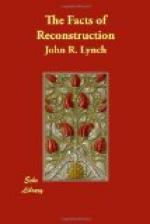The adoption of the George plan was thus assured, but not without a desperate fight. The opponents of that scheme made a brave, though unsuccessful, fight against it. But it was soon made plain to the advocates of the George plan that what they had succeeded in forcing through the Convention would be defeated by the people at the ballot-box. In fact, a storm of protest was raised throughout the State. The Democratic press, as well as the members of that party, were believed to be about equally divided on the question of the ratification of the Constitution as thus framed. Since it was well known that the Republicans would be solid in their opposition to ratification, the rejection of the proposed Constitution was an assured fact. But the supporters of the George scheme felt that they could not afford to have the results of their labors go down in defeat. In order to prevent this they decided to deny the people the right of passing judgment upon the work of the Convention. The decision, therefore, was that the Convention by which the Constitution was framed should declare it duly ratified and approved, and to go into effect upon a day therein named. The people of that unfortunate State, therefore, have never had an opportunity to pass judgment upon the Constitution under which they are living and which they are required to obey and support, that right having been denied them because it was known that a majority of them were opposed to its ratification and would have voted against it.
But this so-called “understanding clause,” or George scheme, is much more sweeping than was intended by its author. The intent of that clause was to make it possible to disfranchise the illiterate blacks without disfranchising the illiterate whites. But as construed and enforced it is not confined to illiterates but to persons of intelligence as well. No man, for instance, however intelligent he may be, can be registered as a voter or vote if registered, if the registering officers or the election officers are of the opinion that he does not understand the Constitution. It is true, the instrument is so worded that no allusion is made to the race or color of those seeking to be registered and to vote; still, it is perfectly plain to everyone that the purpose was to enable the State to do, through its authorized and duly appointed agents and representatives, the very thing the Fifteenth Amendment declares shall not be done. According to the decision of the Supreme Court, as rendered by Mr. Justice Strong, the effect is the same as if the instrument had declared in so many words that race or color should be the basis of discrimination and exclusion.




